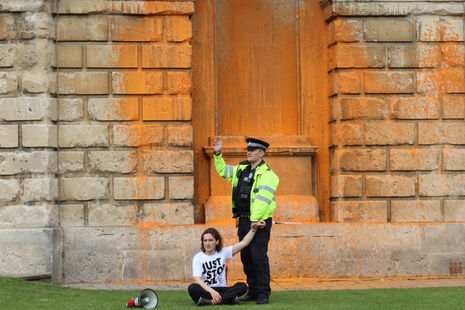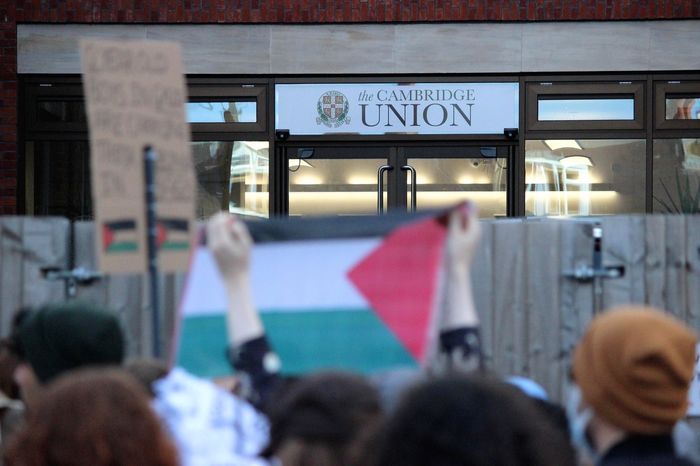‘We can see a better world and a better University’: Cambridge’s protesters on being seen and heard
Alice Mainwood looks back on a year of protest in Cambridge, talking to those behind the scenes and on the frontlines of student activism

Flags, placards, 200 students marching down King’s Parade, drums, fake blood. Smashed windows are countered by Gothic architecture splattered with brightly coloured paint. Protest is inevitably constant in Cambridge. Activist groups in Cambridge are increasing in number, activity, and energy, as the student body becomes progressively more engaged with the link between Cambridge and international crises.
Amnesty International stage an annual protest on the green outside King’s College, seeing a member of the society entrap themselves in a wooden cage, intended to symbolise the plight of different groups suffering under oppressive regimes globally. One who was involved speaks to me about how staging a protest so vehemently engaged with visual performance requires a certain commitment to engaging with University bureaucracy. They tell me how members of the society devoted themselves to constructing the cage, seeking permission from King’s College to access the lawn for the protest, and a plethora of other “institutional barriers”.
“Protests are having to undergo a process of performance”
The cage protest is an enduring concept; the visual performance involved, and the attention it attracts, have proven to generate the society much media attention. Whether or not to co-ordinate the protest for another year was never in question for the society, rather the very people the protest would be in favour of. “We contacted the Sudanese society, and a few Sudanese students we knew, and they were pleased for us to take on this project. It felt really important to shed light on the Sudanese [refugee] crisis as it seems to be slipping through the mainstream cracks,” they tell me.
The cage alone, however, is not always enough to attract the attention of passers by. They recount how they and their fellow protesters had to pair the visual aspect of their claim with “frantic claims” for the attention of passers by. They likewise tell me about the plights of the English rain, the demands of shift-work for such protests, and the constant need to re-explain these humanitarian crises to potential signatories.
These frantic claims and ambivalent passers-by linger in my mind. I had previously wondered what was motivating the shift towards more visual-oriented protests that Cambridge has borne witness to over the last few years, but their recollections affirmed that protest has been forced to become art simply to stand out. It makes sense; in my two years at Cambridge, I cannot remember many times I have walked down an entirely uninterrupted King’s Parade. For better or for worse, a march often doesn’t attract the same attention from the public as it might have done five years ago. Protests are having to undergo a process of performance.
“Visual protest equals visual content, and Chiara and her peers are all too aware of the need to bombard the public with striking visuals”
I spoke to Chiara Sarti, the King’s student who, last October, splattered the outside of the College with orange paint in the name of Just Stop Oil. Chiara doesn’t call what she did a protest, rather finding a more fitting term in calling it an act of civil disobedience. When I asked why she thought we were starting to see this growing intersection between activism and art, she told me that it’s because protesters feel the need to visually transform the institutions that they demand changes from, tarnishing an otherwise esteemed piece of architecture into something damaged, or spoiled. “It’s a place a lot of us can connect to. Most of us have sat and eaten lunch on those walls,” Chiara says.
Visual protest makes it possible to “create an emotional connection” with the places we know, combining that sentimentality with students’ demands for the institutions they criticise. Similar protests performed outside Trinity College, on Cambridge’s West Site, and outside Cambridge Labour’s head offices by activist group This Is Not A Drill seem to reflect the same values.
Chiara was arrested for this act. There’s a growing tendency for visual protest – that which damages the physical holdings of the institutions that are protested against – to entwine itself with breaking the law. Chiara was not surprised when she was arrested; she tells me about the hours she spent training for the likely response that this sort of visual protest would attract. The act of civil disobedience not only provoked action from the police, but also attracted huge media attention. Chiara admitted she couldn’t count how many times she’d been named in the Daily Mail since last December.
That is the point, though, she explains. We talk about how keen major media outlets can be to put a picture of King’s College on the front page; Cambridge is, after all, an unusual hybrid between tradition and modernity. Cover a college in orange paint, and a mass of media attention is sure to follow. Visual protest equals visual content, and Chiara and her peers are all too aware of the need to bombard the public with striking visuals in order to encourage engagement and action.
“Cambridge’s protests are becoming increasingly reliant on variation, on visually eye-catching movements”
The attention that an act of protest outside King’s College can attract is a tool that many have utilised over the last year – from Amnesty International to Just Stop Oil, and most recently Cambridge For Palestine’s encampment demanding the University to disclose and divest from investments in companies supplying the Israeli military.
Any time I have walked down King’s Parade in the last week, I have been struck by how the encampment has changed, even if only slightly, whenever I pass by. A plethora of banners, hung from the walls of King’s College, are accompanied by kites illustrated with poems by Palestinian authors, and cardboard signs trailing the walls, each painted with white, red, and green mantras and chants. A media spokesperson told me that, despite how artwork is coming to life alongside the encampment, and how the lawn has become a living space for protesters, artwork is not being utilised to create a sense of home. “We’re not doing this to have fun,” he tells me. They are instead trying to catch the attention of passers-by, spotlighting Palestinian art.
I was reminded of another walk I’d taken down King’s Parade last September. Turning the corner from Market Square, I was met by a dystopian image: a parade of protesters dressed from head to toe in red cloaks, faces painted white, walking in a solemn procession past Senate House. They were flanked by protesters holding signs far bigger than themselves, and a number of other protesters lying calmly on the ground.
One participant in this protest told me how aware he was of protesters’ reputation for being “full of doom and gloom,” and how he had leant into this perspective in order to highlight their feelings of negativity towards the world as it currently is. He went on to tell me about a protest he took part in where he and other representatives of Cambridge Climate Justice sang and danced to a parodic rendition of ABBA’s ‘Money, Money Money’ to protest the University’s delayed action on climate change.
The breadth of his action shocked me; just within the space of three months he had taken part in both one of the gloomiest, and one of the most joyous embodiments of protest we’ve seen in Cambridge this past year. Recollecting his experience in the flashmob, the student told me that he and his fellow protesters wanted to create a vision of a happier society, free from the bureaucracy that fumbles and mitigates positive climate action. “We can see a better world and a better University,” he professes.
No matter how each activist uses art, they each hold closely to one single sentiment: Cambridge’s protests are becoming increasingly reliant on variation, on visually eye-catching movements, and on finding a voice in the space between activism and art.
 News / Clare Hall spent over £500k opposing busway 24 December 2025
News / Clare Hall spent over £500k opposing busway 24 December 2025 Comment / The ‘class’ of Cambridge24 December 2025
Comment / The ‘class’ of Cambridge24 December 2025 News / Caius mourns its tree-mendous loss23 December 2025
News / Caius mourns its tree-mendous loss23 December 2025 Comment / League tables do more harm than good26 December 2025
Comment / League tables do more harm than good26 December 2025 News / Girton JCR publishes open letter expressing solidarity with Palestine25 December 2025
News / Girton JCR publishes open letter expressing solidarity with Palestine25 December 2025









